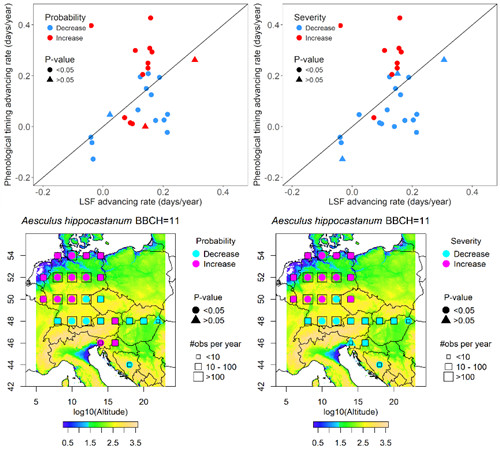

Frost events during the active growth period of plants can cause extensive frost damage with tremendous economic losses and dramatic ecological consequences. Cannell (1985) hypothesized, that climate warming in boreal and temperate zones increases the risk of frost damage to trees. This hypothesis has been addressed in several studies with modeling and experimental approaches, however, a consensus whether the risk of plants to encounter spring frost damage due to recent warming has increased, or decreased, has not been reached. On one hand, climate warming may bring along a reduction in the frequency and severity of frost damage to vegetation. On the other hand, it has been argued that rising temperature in late winter and early spring might trigger the so called “false spring”, i.e., early onset of growth that is followed by cold spells, resulting in increased frost damage. We examined the well‐known “increased frost damage” hypothesis by Cannell (1985), based on long-term phenological records and climate. By combining daily gridded climate data and 1489k in situ phenological observations of 27 tree species from 5565 phenological observation sites in Europe, they found that temporal changes in the risk of spring frost damage with recent warming vary largely depending on the species and geographical locations. Species whose phenology was especially sensitive to climate warming tended to have increased risk of frost damage. Geographically, compared with continental areas, maritime and coastal areas in Europe were more exposed to increasing occurrence of frost and these late spring frosts were getting more severe in the maritime and coastal areas. This study suggests that even though temperatures will be elevated in the future, some phenologically responsive species and many populations of a given species will paradoxically experience more frost damage in the future warming climate. More attention should be paid to the increased frost damage in responsive species and populations in maritime areas when developing strategies to mitigate the potential negative impacts of climate change on ecosystems in the near future.
This study is published in Global Change Biology (2017IF=8.997, Rank:1/55 in Biodiversity Conservation; 3/241 in Environmental Sciences; 5/158 in Ecology) titled with "Divergent trends in the risk of spring frost damage to trees in Europe with recent warming ". This study was primarily funded by National Natural Science Foundation of China, the 100 Talents Program of the Chinese Academy of Sciences (CAS), Natural Science Foundation of Guangdong Province, CAS/SAFEA International Partnership Program for Creative Research Teams.


